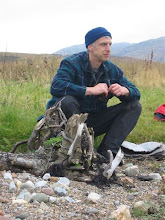 It was a bit murky as I drove down the track to the car park at Flanders yesterday, a fresh inch of snow covered the ground and the sun was yet to break through the Carse mist. I clocked the usual rooks and pheasants pinching the sheep's food from their troughs and suddenly pulled up with a sudden jerk as I realised that the stubble field next to the track was absolutely filled with birds. It took me a moment to realise that they were pinkies, pink-footed geese and there was an awful lots of them. I got to the end of the track going very slowly so as not to spook them and then did a quick estimate of numbers. 2500-3000 was the guesstimate and quite a site they made. The sounds of their calls came in waves across the field (pinkies make more of a "wink wink" sound, greylags more of a "wank, wank" - this method of telling them apart isn't for sharing with all visitors on the moss) as they walked back across the field away from me. I did a quick scan across the group for any other species of geese that might be mixed in, in the past we have seen a few barnacle geese, a snow geese and even an odd hybrid mixed in with flocks at Flanders. I also checked for neck rings, these are coloured bands around the neck with a unique code on them that researchers use to track individual birds. They are much easier to read in the field than leg rings. The bustle and noise of the geese moving from field to field as they fed and of more geese flying in in groups brought the landscape alive as the sun burned gaps in the mist and back lit the scene.
It was a bit murky as I drove down the track to the car park at Flanders yesterday, a fresh inch of snow covered the ground and the sun was yet to break through the Carse mist. I clocked the usual rooks and pheasants pinching the sheep's food from their troughs and suddenly pulled up with a sudden jerk as I realised that the stubble field next to the track was absolutely filled with birds. It took me a moment to realise that they were pinkies, pink-footed geese and there was an awful lots of them. I got to the end of the track going very slowly so as not to spook them and then did a quick estimate of numbers. 2500-3000 was the guesstimate and quite a site they made. The sounds of their calls came in waves across the field (pinkies make more of a "wink wink" sound, greylags more of a "wank, wank" - this method of telling them apart isn't for sharing with all visitors on the moss) as they walked back across the field away from me. I did a quick scan across the group for any other species of geese that might be mixed in, in the past we have seen a few barnacle geese, a snow geese and even an odd hybrid mixed in with flocks at Flanders. I also checked for neck rings, these are coloured bands around the neck with a unique code on them that researchers use to track individual birds. They are much easier to read in the field than leg rings. The bustle and noise of the geese moving from field to field as they fed and of more geese flying in in groups brought the landscape alive as the sun burned gaps in the mist and back lit the scene.I had gone out to Flanders to meet a Tim and Maeve from the BBC. They are making a series of programmes about man's impact on the landscape and were interested in the peat clearances of the 18th and 19th century. They had come to see Flanders not so much because of the bog itself but to see the contrast between the remaining bog and the land where bog had been cleared from. It is hard to get over to people the shear effort that went into the clearing of the peatlands on the Carse, hundreds of thousands of peat were removed to get at the good agricultural land underneath, this activity would have totally dominated local people lives 200 years ago. The landscape would have looked very different with smoke from the burning waste peat rolling over black fields, the workers houses almost indistinguishable from the land itself, and everything stained black. I am not sure if I was able to get this over to the BBC crew but they were very taken with the wobble of the bog when you jump up and down on it and the ease that you can push a stick into the deep soft peat. So we will have to see how they will portray the moss of today.



